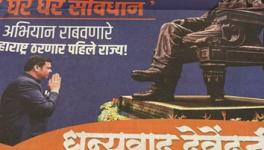Hijab, Ram Navami and the Legend of Bhagat Singh

Women stage a protest over the hijab ban imposed in the few colleges in Karnataka
In 2018, Abhimanyu, a student from Vattavada in Munnar and leader of the Students Federation of India (SFI) leader at Maharaja’s College, Kochi, was stabbed to death at the gate of the college while he was writing the slogan “Stop Communalism” on a wall. Assailants recruited from different parts of the state by the Campus Front of India (CFI), the student wing of the Popular Front of India, a militant Islamist group, allegedly committed the crime.
There was no history of any violence or scuffle in the preceding months between any groups, let alone the SFI and CFI, which stood as testimony to the predetermined nature of the murder. While the entire state, cutting across party lines, stood in solidarity against the cold-blooded crime, the CFI remained unapologetic. Soon, it was revealed that the enmity was not against an individual or his organisation. A leader of the CFI underscored the said line of thought during a prime-time debate, in which he accused the college of allowing male and women students to mingle, thereby causing moral erosion.
So, it would not be an exaggeration to suggest that the heinous murder was designed to terrorise the progressive campus culture, as no other motive stood out, even if one stretches the imagination. They were determined to eliminate not just an individual but a space—a secular one, which communal fanatics of all colours abhor.
This incident occurred to me on reading the news last month that Akhil Bharatiya Vidyarthi Parishad (ABVP) members allegedly installed a makeshift Rama temple at the Central University of Hyderabad. The brutal assault against the students of JNU for preferring to eat non-vegetarian food as per their hostel menu is also still fresh. Simultaneously, Ram Navami celebrations were held on the campus, again allegedly by ABVP activists.
Two years ago, the campus witnessed an even more severe attack when masked goons using rods and bricks, with visible police cover, seriously injured students and faculty members. Curiously, even at that time, the moralistic rhetoric Sangh Parivar outfits propagated against JNU was on similar lines as the arguments of CFI activists against Maharaja’s College after Abhimanyu’s killing.
“They are projecting it as a symbol of everything that is bad in this country, and that is why they need to destroy it,” writer and commentator Nilanjan Mukhopadhyay told the New York Times after the incident. Mukhopadhyay, who has studied the RSS for many years, also said the attack on JNU was ‘a precursor to shutting down the university and “trying to reshape it”.’
Take a close look at the recent hijab row in Karnataka. The ABVP and the CFI were competing by fanning the flames of divisiveness and benefiting from it by running robust recruitment drives. Coastal Karnataka has become a playground of communal tensions, and the very foundation of this design started with the communalisation of coastal schools.
There is a growing trend among parents to send their wards only to schools run by their respective communities. This is a direct consequence of the propaganda by the communal organisations (not only in Karnataka) to this effect. Colleges are the first sphere where young men and women get to become friends and co-scholars, cutting across religious lines. However, with conditioning beginning at a very young age, they are often powerless to emerge from the communal cocoon.
This phenomenon is weakening secular organisations such as the SFI and NSUI, which used to win college elections. It further leaves the stage open to communal organisations like the ABVP and CFI.
Though there are widespread attempts to communalise every possible domain of society, attempts to divide students among communal lines deserve detailed scrutiny. “Catch them young” has always been a favourite motto of fascistic forces, from the times of Hitler and Mussolini.
The RSS, which fashions itself along the lines of its German and Italian counterparts, revived its organisation from the fiasco after the assassination of Gandhi by establishing a parallel countrywide network of educational institutions.
In the film Ishqiya, after reaching a remote village, the character played by Arshad Warsi wittily tells the character Naseeruddin Shah plays, “Yahan toh Pandit, Thakur, sab apney-apney fauj bana rakhe hain—Here, Pandits, Thakurs and others have formed their own armies’. It is a travesty that our villages are divided along caste and communal lines even today, though there are increasing exemptions. It is the secular public education system that paved the way for children from diverse castes and religious backgrounds to know each other. This interaction allowed them to realise that they are all equal as citizens, as visualised by the Constitution.
It may be unrealistic to suggest that a person who has received secular education in a secular environment will be subject to a change that is drastic enough to overcome all the indoctrination they received since childhood. However, the seeds of change are sown in schools and colleges. For, once students witness that another world is possible, it is difficult to reverse that progress. Our public education system has contributed significantly to the republic by remaining the bedrock of secular goals. The communalists have realised that to divide the country emotionally and geographically, they have to destroy that foundation. The targeted attack on prestigious secular educational institutions and the injection of communal poison into young minds are part of this larger plan.
When we talk about communalism and the youth, there is no inspiration superior to the youth icon Bhagat Singh. Though Hindutva groups have consistently tried to appropriate him, it is well known that he considered communalism as evil as colonialism. Two rules of the Naujawan Bharat Sabha Bhagat Singh drafted are instructive. He said it would “have nothing to do with communal bodies or other parties which disseminate communal ideas” and “create the spirit of general toleration among the public considering religion as a matter of personal belief of man and to act upon the same fully.”
Besides other reasons, Bhagat Singh considered economic causes are at the root of communalism. Though the founding mothers and fathers of the Constitution dreamt of freedom—political, social and economic—India is still stuck with just the first, achieved in 1947. In the journey of our republic towards the unfulfilled dreams of the people, communalism and casteism have created the greatest stumbling blocks.
To remove these obstacles that once divided and deeply wounded the country, we must ensure young minds are freed of communal venom. It is beyond doubt that the youth, who are always agents of change, will overcome the sinister plan of the communalists with flying colours. They have always done so. No bigotry can divide them for long when they share food, music, love, and dreams of a better place for themselves and future generations. After all, they are the descendants of Bhagat Singh.
The author is a lawyer practising in the High Court of Kerala. The views are personal.
Get the latest reports & analysis with people's perspective on Protests, movements & deep analytical videos, discussions of the current affairs in your Telegram app. Subscribe to NewsClick's Telegram channel & get Real-Time updates on stories, as they get published on our website.
























